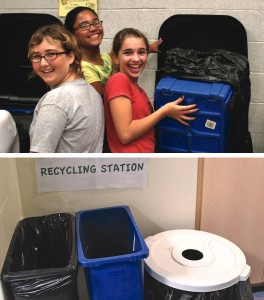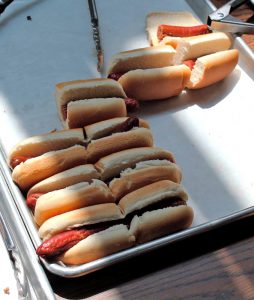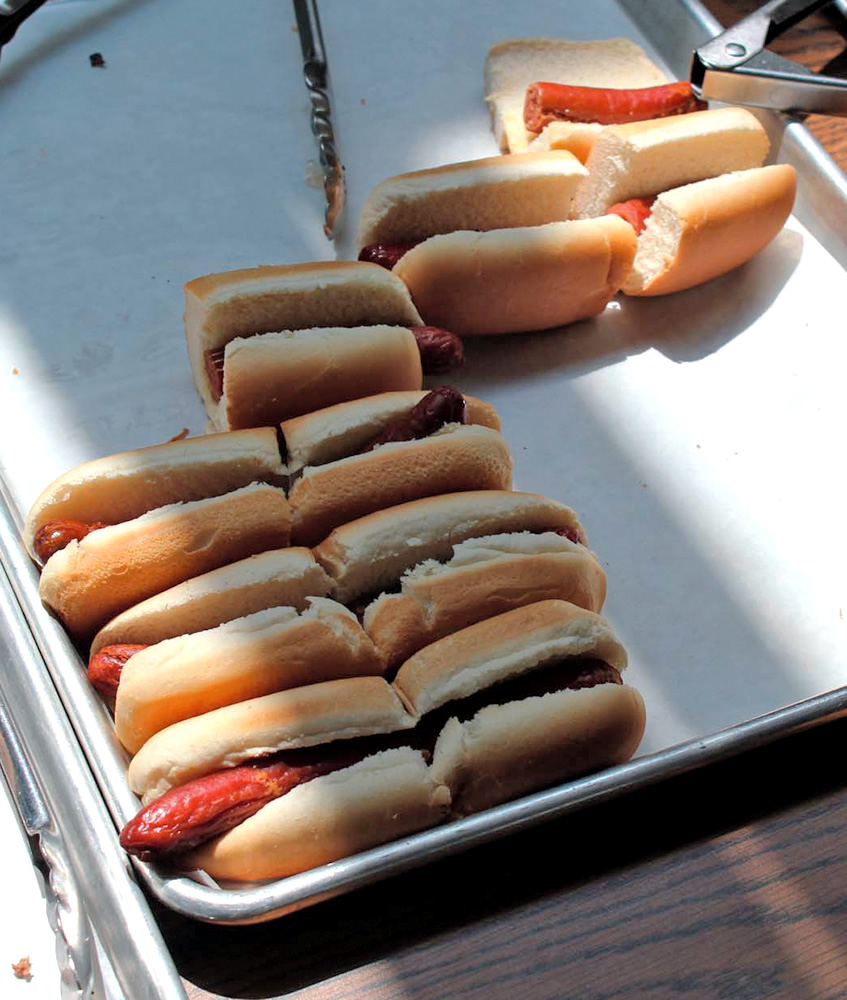After two decades of engaging K-12 schools to implement recycling and food waste composting, the author provides insights on how to ensure program longevity.
Priscilla E. Hayes
BioCycle February 2013, Vol. 54, No. 2, p. 40
New Jersey’s Recycling Act was still new in the early 1990s when I became involved with school recycling. I learned that the township’s one school was not recycling. With the courage of my legal training (I am a lawyer turned educator), I simply told the head custodian that he had to work with the hauler to get recycling dumpsters for the rear of the school, and he did. Schools had not yet begun to argue that they were not recycling because it would cost the taxpayer more money — in contradiction to the law.
I had read a study showing that students could learn academic skills and disciplines especially well within the context of hands-on projects and activities. Students needed to be the ones to collect recyclables and take them to where the custodian could put them in the newly acquired dumpsters. One parent protested that this was forced child labor. Thankfully, I had more than the law and conviction on my side. I had Helen DiPascale, a bright and inspiring primary school teacher who dreamed up a classroom paper recycling system that involved little red wagons.

Students often are involved in collection of recyclables from classrooms (top). Clustering trash and recycling bins in the halls improves the capture of recyclables (bottom).
In 2011, I became Director of Energy and Sustainability for Far Hills Country Day School in New Jersey. I inherited the Fifth Grade Green Team, whose chief responsibility is picking up paper being recycled from the preschool through 5th grade classrooms. At the beginning of the 2012-2013 school year, I sent out a request for new 5th graders to join the team, and asked them to write a letter explaining why they should be selected. More than one letter stated they had been waiting to be on the team for several years. Out in the school’s new Learning Garden, a recess alternative that allows students to work in the garden, a group of 3rd and 4th graders explained that they were the Junior Green Team — members in waiting for the time they could be on the 5th grade team.
In the more than two decades since that first school, especially during the 15 years I spent as Director of the Solid Waste Resource Renewal Group (SWRRG) at Rutgers University’s New Jersey Agricultural Experiment Station, I have been invited to help many schools with recycling. I have looked into hundreds of trash cans and recycling bins, sorted food waste from plastic and paper, moved bins or recommended removing bins. Here are key lessons I’ve learned.
Lesson #1: Value of a Team
Lavallette Elementary School is a 150-student K-8 school on a barrier island on Barnegat Bay in New Jersey. George Solly, the head school custodian, had been helping students and staff separate recyclables from trash, without being provided any dedicated dumpsters or other containers for the separated items. He made sure recyclables were in separate bags for pick up, but learned they were being mixed back with the trash after pick up from the school. Solly approached the newly formed Environmental Club, whose student members had already begun to target school recycling as one of its priority projects, about working together. With support from the principal and school district, Solly and the two dedicated teacher-advisors and student members developed a recycling system for mixed paper, cardboard, batteries, bottles, cans, printer cartridges and cell phones. Each classroom was fitted with two recycling bins, in addition to the existing trash bins. Sixth and seventh grade members of the Environmental Club arrived early one or two mornings a week to work in teams, collecting recyclables from the classrooms, offices, library and other rooms. They would remove contaminants and carry sorted recyclables to the cafeteria and empty them into wheeled totes. Solly wheeled full totes out to the back for separate recycling pickups. Not leaving anything to chance, the first Environmental Club members created a Power Point, which they presented to everyone in the school, to train them as to proper recycling separation.
Lesson #2: Value of Being an Insider
I first visited Far Hills Country Day School (FHCDS), where I am now employed, to conduct a waste audit. I was swept off my feet by the dedication to school recycling. The cafeteria had a basin with soapy water and scrub brush for the students themselves to clean their used yogurt cups for recycling! The kitchen crew presented children with burgers and hotdogs cut in half, suggesting they take only a half at first. During my waste audit, I observed that the school had already adopted clustering nearly everywhere — hall trash bins were all clustered with both bottle and can and paper and cardboard bins. The Fifth Grade Green Team took an active role in the waste audit, scattering with my survey sheets to peer into bins and estimate contamination levels.

Kitchen staff at the Far Hills Country Day school cut hot dogs and hamburgers in half before serving to help reduce wasted food.
Lesson #3: Commitment to Recycling and Sustainability
When I was at SWRRG, Hopewell Valley Central High School requested help to begin a composting program. A team of students had won a Lexus Group grant based on a proposal to compost some of the food waste at the school. The grant included $3,000 for purchase of composting equipment and other supplies. The art teacher had already started a Recycling Club in response to student requests. About 50 students are in the club, with about 10 to 20 showing up for twice weekly collection days to transport recyclables to the containers in the rear of the school. A separate Compost Club collects 5 to 10 gallons worth of fruit/vegetable waste from the cafeteria daily, which are put into one of three composters, and mixed with shredded paper, sawdust or shredded leaves. Compost is used on ornamental beds. The eight students in the club take turns collecting material for the composters.
Both the Recycling and Compost Clubs have full support from the school’s administration, faculty and staff. The school culture has gone from one where staff members predicted that recycling would never work, to one where everyone places their bins outside the classroom/office door on recycling days to facilitate student collection. Support for the programs goes beyond the school, having the endorsement of the entire school district through Norman Torkelson, a former science teacher and energy-efficiency contractor, who now serves as the District’s Director of Facilities, and leads a “Holistic Sustainability” effort district wide.
Lesson #4: Academic Content Standard
Although each of the programs discussed has been successfully sustained for some years, very little integration of recycling into the curriculum has been reported. Moreover, program support has extended only as high as the local school district, if even that high. In a statewide approach, Ohio is tiptoeing into the realm by incorporating recycling into scientific principles of one of the core academic standards statewide. For example, the Ohio Department of Education’s Model Curriculum/Grade 3/Earth and Space Science is based on the premise that some of Earth’s resources have become limited due to overuse and/or contamination, and that reducing resource use, decreasing waste and/or pollution, recycling and reusing can help conserve these resources. The standard provides classroom examples, such as “Design and carry out a plan to reduce the use of specific resources at the school, school district, or local community” and ”Plan and implement an investigation to collect and analyze data pertaining to the school’s recycling rate to determine what types of materials have a high recycling rate and which have low rates (and reasons why). Graph and present the findings to school administrators or community officials.” This standard, one of a new version of all Ohio State Academic Content Standards, is intended to become fully effective with the 2014/15 school year.
Lesson #5: Lead With The Law
In New York City, K-12 grade schools are required by law to recycle. Over my 20 years of school recycling experience, I have been advised (as a recovering attorney) not to lead with the law, but rather convince schools to recycle by showing what the economic benefits can be. Since realizing economic benefits requires schools to really examine their trash and recycling contracts, and be active in telling their haulers to provide smaller trash containers or less frequent trash pickups or both, this is not an instant sell. The reality is that recycling has been mandatory for decades, but schools haven’t been required to comply. Schools’ compliance with the law should, by default, serve as the basis for the recycling program.
Lesson #6: Children Learn What They Live
It is precisely because of the school’s mission to educate that they must recycle, since it is clear that kids will learn what they live, what they see, and if recycling is not part of that, we can never expect them to learn behaviors that are essential for their own future quality of life.
Lesson #7: Start With Participatory Audit
Hands-on involvement in recycling is not only place-based education but opens eyes — of both students and teachers/staff. A school should start with a participatory waste audit, involving as many people in the school as possible. Kids and staff will discover for themselves the opportunities to source reduce, compost and recycle.
Lesson #8: Teaching Opportunities
Recycling and food waste composting initiatives present special teaching, as well as cost saving, opportunities for school districts. These programs provide a setting for scientific demonstration, and real life data collection, mathematics, word problems and calculations. Studies have shown that students learn math and science and other basic skill areas better in a real life environmental context.
Lesson #9: Involve Custodial And Kitchen Staff
The custodians and kitchen staff are your best friends. Be respectful and responsive; listen when they tell you about the ants. These are the people who need to be involved. At the same time, they need to be responsible for follow through as well.
Priscilla Hayes is Director of Energy and Sustainability at Far Hills Country Day School in New Jersey.










